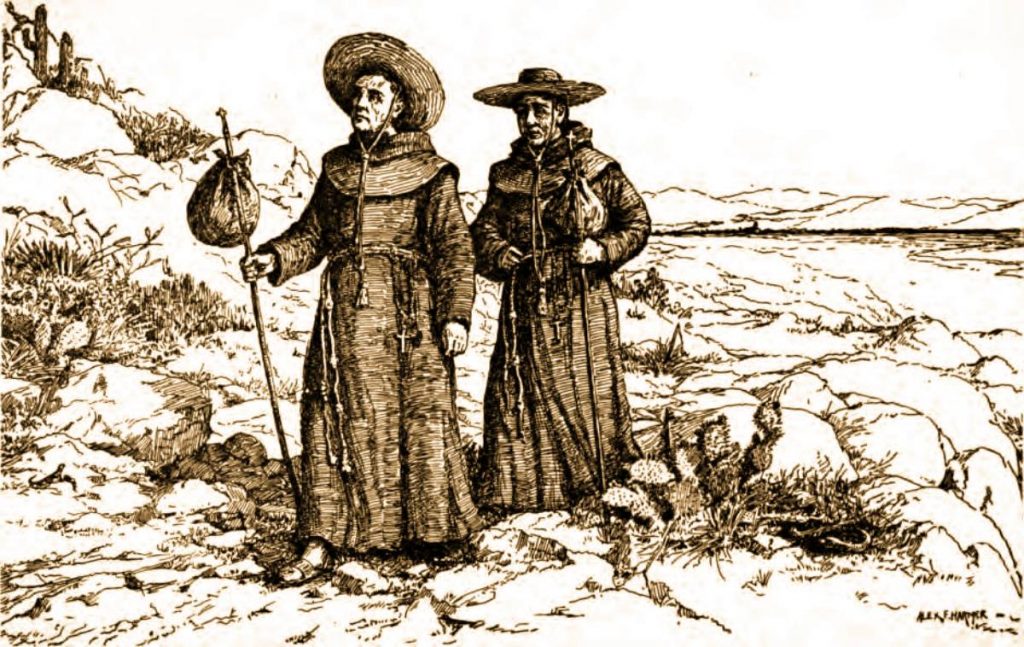Missionary Journeys And The Power Of Spiritual Dissemination
In the realm of spiritual exploration and spreading religious teachings, Missionary Journeys have played a pivotal role throughout history. These journeys involve individuals, often affiliated with religious organizations, traveling to distant lands with the aim of sharing their faith and serving communities. In this comprehensive article, we delve into the significance, historical context, and impact of missionary journeys, shedding light on their profound role in shaping cultural and religious landscapes.
Author:Jane RestureDec 21, 202326K Shares473.5K Views

In the realm of spiritual exploration and spreading religious teachings, Missionary Journeys have played a pivotal role throughout history. These journeys involve individuals, often affiliated with religious organizations, traveling to distant lands with the aim of sharing their faith and serving communities. In this comprehensive article, we delve into the significance, historical context, and impact of Missionary Journeys, shedding light on their profound role in shaping cultural and religious landscapes.
Understanding Missionary Journeys
Definition And Purpose
Missionary Journeys serve as a testament to the deep dedication of individuals, referred to as missionaries, undertaking expeditions with the primary objective of sharing religious beliefs. These journeys extend beyond mere proselytization, weaving a rich tapestry of activities that significantly contribute to the intricate fabric of human connection and understanding. For a deeper exploration of the profound impact of missionary endeavors, one can refer to the Fellowship Bible Church website.
Evangelism
At the core of Missionary Journeys is the act of evangelism — the intentional sharing of religious doctrines with individuals who may be unfamiliar with a particular faith. Missionaries ardently believe in the transformative power of their spiritual teachings, and their journeys become a conduit for the dissemination of these beliefs to diverse and often remote communities.
Community Service - A Holistic Approach
While evangelism forms a significant aspect, Missionary Journeys extend their purpose to include community service. Missionaries immerse themselves in the daily lives of the communities they serve, offering practical assistance, humanitarian aid, and contributing to local development. This holistic approach not only addresses spiritual needs but also attends to the tangible challenges faced by the communities.
Cultural Exchange
An integral facet of Missionary Journeys is the pursuit of cultural exchange. Missionaries recognize the richness of diversity across the globe and actively engage with the traditions, customs, and languages of the communities they encounter. By fostering mutual understanding, missionaries seek to bridge cultural divides and create spaces where the shared human experience can flourish.
Deeper Understanding - Nurturing Connections
Beyond the immediate goals of evangelism, community service, and cultural exchange, Missionary Journeys aspire to foster a deeper understanding of the intricacies of diverse cultures. This involves active listening, empathetic learning, and an openness to adapting approaches based on the unique context of each community. The nuanced understanding gained during these journeys enhances the effectiveness and authenticity of the missionary's engagement.
Spiritual Insights - Sharing The Light Within
At the heart of Missionary Journeys is the desire to share spiritual insights that transcend cultural and linguistic barriers. Missionaries believe in the universality of certain truths and seek to illuminate the paths of others with the light of their faith. This sharing of spiritual insights is not only an act of propagation but also a gesture of goodwill, fostering a sense of interconnectedness among diverse peoples.
Historical Perspectives
Early Missionary Activities
Missionary Journeys, with their roots deeply embedded in the annals of ancient history, mark the beginnings of the global dissemination of major world religions such as Christianity, Islam, Buddhism, and Hinduism. In the dawn of religious fervor, early missionaries undertook daunting expeditions, navigating uncharted territories on foot or by sea. Their unwavering commitment led them to remote regions, where the resonance of their teachings had the potential to make a profound impact on the spiritual landscape.
Ancient Trails Of Devotion
The origins of Missionary Journeys can be traced to the fervent dedication of individuals who, compelled by their faith, embarked on journeys that transcended geographical boundaries. These early missionaries, often driven by a fervent belief in the transformative power of their doctrines, undertook arduous travels that showcased unparalleled resilience in the face of physical and cultural challenges.
Arduous Travels On Foot And Sea
Early missionaries faced the formidable task of traversing vast distances on foot or braving treacherous seas to reach destinations far beyond the familiar realms of their origin. The arduous nature of these journeys underscored the missionaries' determination to carry their spiritual message to corners of the world where it had not yet taken root.
Connecting With New Communities
The hallmark of early Missionary Journeys was the missionaries' unyielding commitment to connecting with new communities. These journeys were not just about the propagation of religious beliefs but also about establishing genuine connections with diverse groups of people. In doing so, missionaries became cultural ambassadors, fostering mutual understanding amid the diversity of human experience.
The Age Of Exploration And Missionaries
The 15th to 17th centuries marked a pivotal era known as the Age of Exploration, during which Missionary Journeys experienced a remarkable surge. This period coincided with the exploration and colonization endeavors of European powers in distant lands. Missionaries played a significant role in this era of cultural intersection, introducing new religious perspectives and navigating the delicate balance between cultural adaptation and preservation.
Symbiosis Of Exploration And Evangelism
The Age of Exploration saw a convergence of geographical discovery and religious propagation. European powers, driven by the pursuit of new trade routes and territories, ventured into uncharted lands. Missionaries accompanied these expeditions, seizing the opportunity to introduce their faith to cultures previously untouched by the doctrines they espoused. The symbiosis of exploration and evangelism became a defining feature of this historical epoch.
Bridging Cultures And Adapting Perspectives
Missionaries in the Age of Exploration were cultural intermediaries, bridging the gap between the known and the unknown. They navigated the intricate tapestry of diverse cultures, adapting their perspectives to resonate with local customs while simultaneously introducing novel religious ideologies. This delicate balancing act between cultural sensitivity and religious fervor shaped the course of Missionary Journeys during this transformative age.
Challenges And Controversies
Cultural Clashes
Missionary Journeys, despite their noble intentions of fostering understanding and spiritual connection, have encountered formidable challenges in the form of cultural clashes. As missionaries set foot in diverse communities, they often faced resistance from individuals and societies unwilling to embrace foreign beliefs. The clash between the missionaries' evangelistic zeal and the deep-rooted traditions of the communities they sought to influence created a complex dynamic.
Unraveling Cultural Resistance
Cultural clashes manifested as a consequence of the inherent tension between the missionaries' desire to impart their spiritual teachings and the resistance from communities guarding their cultural heritage. The unfamiliarity of foreign doctrines often sparked skepticism, and missionaries found themselves navigating a delicate balance between introducing new beliefs and respecting the cultural fabric of the
Striking A Balance
The challenge for missionaries was to strike a delicate balance between respecting local traditions and promoting their own teachings. Navigating this dilemma required a nuanced understanding of the intricacies of diverse cultures. Missionaries had to grapple with questions of cultural sensitivity, adapting their approaches to resonate with the communities they served without compromising the essence of their religious message.
Ethical Concerns
Missionary activities, while driven by a sense of spiritual duty, have been subjected to ethical scrutiny, giving rise to concerns regarding cultural imperialism and the potential imposition of foreign values. Critics argue that some missionaries, perhaps unintentionally, contributed to the erosion of indigenous cultures, prompting ongoing debates about the ethical boundaries of spreading religious beliefs.
Cultural Imperialism And Imposition
Ethical concerns surrounding Missionary Journeys often revolve around the concept of cultural imperialism. Critics contend that missionaries, in their zeal to propagate their faith, may inadvertently contribute to the erosion of local cultures by imposing foreign values. The imposition of a new belief system, sometimes perceived as superior, raises ethical questions about the impact on the autonomy and cultural identity of the communities being influenced.
Debates On Ethical Boundaries
The ethical boundaries of missionary activities have been a subject of continuous debate. Scholars, religious leaders, and community representatives engage in discussions about the potential unintended consequences of missionary efforts. These debates encompass issues of cultural preservation, respect for indigenous knowledge, and the ethical responsibility of missionaries to ensure their activities do not infringe upon the autonomy and dignity of the communities they serve.
Contemporary Missionary Journeys
Globalization And Technology
In the ever-evolving landscape of the contemporary era, Missionary Journeys have undergone a transformative evolution, intricately entwined with the forces of globalization and technological advancements. The advent of air travel, the omnipresence of the internet, and the pervasive influence of social media have collectively redefined the contours of missionary outreach, offering both unprecedented opportunities and novel challenges.
Air Travel
One of the defining features of contemporary Missionary Journeys is the accessibility afforded by air travel. Missionaries can now traverse vast distances in a matter of hours, facilitating expedited movement between diverse regions. This newfound speed enhances the efficiency of missionary activities, allowing for broader geographical coverage and a more agile response to emerging needs in various corners of the world.
The Internet
The internet has emerged as a powerful tool, transforming Missionary Journeys into a virtual frontier. Missionaries leverage websites, blogs, and online platforms to share their teachings, engage with virtual communities, and disseminate spiritual insights globally. This virtual presence transcends physical boundaries, enabling missionaries to reach individuals who may not have been accessible through traditional means.
Social Media
Social media platforms have become indispensable allies in contemporary missionary endeavors. Missionaries utilize platforms such as Facebook, Instagram, and Twitter to amplify their outreach, sharing stories, testimonies, and teachings with a global audience. The interactive nature of social media fosters real-time connections, enabling missionaries to engage with diverse communities and build virtual networks that transcend geographical constraints.
Interconnectedness
The interconnectedness facilitated by globalization and technology presents both new opportunities and challenges for the practice of missionary work. On the positive side, missionaries can connect with diverse audiences, fostering cross-cultural dialogue and understanding. The speed of communication allows for swift responses to humanitarian needs, and the virtual realm opens avenues for collaboration and resource-sharing among missionaries globally.
Challenges Of The Digital Age
However, the digital age also introduces unique challenges. The rapid dissemination of information can lead to cultural misunderstandings, and the virtual nature of interactions may lack the depth of face-to-face engagement. Additionally, the potential for information overload poses a challenge in ensuring that the spiritual message remains clear and impactful amid the vast sea of online content.
Contrasting Legacies In A Modern Context
Unveiling The Legacy Of Medieval Missionaries
In the annals of history, Medieval Missionaries stand as pioneers, venturing into uncharted territories to spread religious beliefs during a time marked by limited communication and arduous journeys. The medieval period witnessed the fervent zeal of missionaries who traversed rugged landscapes on foot, faced the challenges of linguistic diversity, and encountered cultures vastly different from their own. As we explore the differences between Medieval Missionaries and their modern counterparts, a nuanced understanding of their contrasting legacies emerges.
Mode Of Travel - Footsteps Vs. Air Travel
Medieval Missionaries undertook their journeys primarily on foot, enduring grueling treks that spanned continents. In contrast, contemporary missionaries benefit from the efficiency of air travel, allowing them to cover vast distances in a fraction of the time. This shift in transportation methods has not only reduced the physical hardships faced by missionaries but has also accelerated the pace of outreach, enabling them to reach diverse global destinations swiftly.
Communication - Manuscripts Vs. Digital Platforms
Communication in medieval times relied on handwritten manuscripts and verbal dissemination. Modern missionaries, however, harness the power of digital platforms, leveraging the internet and social media to disseminate teachings globally. While medieval missionaries had to contend with the time-consuming process of copying manuscripts, their modern counterparts can instantaneously share religious insights, fostering real-time connections and facilitating cross-cultural dialogues.
Cultural Understanding - Adaptation Vs. Cultural Sensitivity
Medieval missionaries navigated unfamiliar territories, often grappling with linguistic barriers and cultural disparities. In contrast, contemporary missionaries, armed with a wealth of information and cultural awareness, emphasize cultural sensitivity. They strive to understand and respect local customs, adapting their approaches to resonate with the diverse communities they encounter. This shift reflects an evolution from mere adaptation to a more profound commitment to cultural understanding.
Ethical Considerations - Colonial Legacy Vs. Ethical Scrutiny
The medieval era, marked by colonial expansion, witnessed a complex interplay between missionary activities and the spread of imperial power. Modern missionaries, however, operate in an era of heightened ethical scrutiny. Debates surrounding cultural imperialism and the imposition of foreign values are integral to contemporary missionary endeavors. The ethical discourse has evolved, prompting a greater awareness of the potential impact on indigenous cultures.
Globalization - From Local To Global Impact
Medieval Missionaries primarily operated within localized spheres, constrained by the limitations of transportation and communication. In contrast, modern missionaries navigate a globalized world, wherein interconnectedness facilitates broader outreach. The interconnected nature of the contemporary era allows missionaries to engage with diverse audiences, fostering cross-cultural connections that extend far beyond the immediate localities of their origins.
Missionary Journeys - FAQs
What Is The Meaning Of Missionary Journey?
A missionary journey refers to an expedition undertaken by individuals known as missionaries, who are devoted to spreading religious beliefs. These journeys involve traveling to different geographic locations, often distant or culturally diverse, with the primary goal of sharing their faith, engaging in evangelism, providing community service, and fostering cultural exchange. The term encapsulates the physical and spiritual exploration undertaken by missionaries to connect with and influence diverse communities.
What Was The Purpose Of Missionary Journeys?
The purpose of missionary journeys is multifaceted, encompassing various dimensions of religious, cultural, and humanitarian outreach. The primary goals include:
- Evangelism:Missionary journeys aim to spread religious doctrines and beliefs to individuals who may not have been exposed to a particular faith. This involves actively engaging with communities to share spiritual insights and teachings.
- Community Service:Beyond evangelism, missionaries often engage in community service, providing practical assistance, humanitarian aid, and contributing to the well-being and development of the communities they serve.
- Cultural Exchange:Missionary journeys seek to foster a deeper understanding of diverse cultures by actively engaging with local traditions, customs, and languages. This cultural exchange is integral to building connections and bridging cultural divides.
- Deeper Understanding:Missionaries aspire to gain a nuanced understanding of the communities they interact with, adapting their approaches to resonate with the unique context of each location. This deeper understanding enhances the authenticity and effectiveness of their missionary work.
What Were The Three Missionary Journeys?
The reference to "the three missionary journeys" typically pertains to the journeys undertaken by the Apostle Paul, a prominent figure in early Christianity. These journeys are extensively documented in the New Testament of the Bible, particularly in the Acts of the Apostles. The three missionary journeys of the Apostle Paul are as follows:
- First Missionary Journey (AD 46–48):Paul, accompanied by Barnabas and later by Silas, embarked on this journey, traveling through Cyprus and Asia Minor. Key destinations included Antioch, Iconium, Lystra, and Derbe.
- Second Missionary Journey (AD 49–52):Paul, accompanied by Silas and later joined by Timothy and Luke, journeyed through Asia Minor and into Europe. Notable locations visited include Philippi, Thessalonica, Berea, Athens, and Corinth.
- Third Missionary Journey (AD 53–58):Paul's third journey took him primarily through Asia Minor, focusing on strengthening the existing Christian communities. Key cities visited include Ephesus, Troas, and Corinth.
Conclusion
Missionary Journeys, a timeless practice rooted in the human quest for spiritual connection, have left an indelible mark on global cultures. From the ancient trails of early missionaries to the modern avenues of digital communication, the evolution of Missionary Journeys reflects the dynamic interplay between faith, culture, and human connection. As we navigate the complexities of this spiritual odyssey, understanding and appreciating the historical, cultural, and ethical dimensions is essential for a holistic perspective on Missionary Journeys in our ever-changing world.

Jane Resture
Author
Since she embarked on her first world trip in 2002, Jane Resture spent the past decades sharing her personal journey and travel tips with people around the world. She has traveled to over 80 countries and territories, where she experienced other cultures, wildlife she had only read about in books, new foods, new people, and new amazing experiences.
Jane believes that travel is for everyone and it helps us learn about ourselves and the world around us. Her goal is to help more people from more backgrounds experience the joy of exploration because she trusts that travel opens the door to the greatest, most unforgettable experiences life can offer and this builds a kinder, more inclusive, more open-minded world.
Latest Articles
Popular Articles




